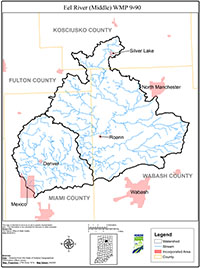Eel River (Middle) WMP 9-90
Summary
The Middle Eel River Watershed Management Plan is a comprehensive and collaborative effort that provides a framework for coordinating activities and efforts within the Middle Eel River Watershed to achieve the following mission statement “To protect and enhance the water resources of the Middle Eel River Watershed through education and implementation of soil and water conservation practices”. The Middle Eel River Watershed Management Plan addresses nonpoint source water pollution of the Middle Eel River by: documenting current water quality conditions, biological integrity, and physical characteristics; identifying potential causes and sources of pollution; identifying strategies to improve water quality; and raising awareness through a public education and outreach campaign.
There are two Eel Rivers in Indiana, one in northern Indiana (HUC 05120104) and one in west central Indiana (HUC 05120203). The focus of this WMP is the northern Eel River. The watershed of the Eel River comprises a land area of 529,968 acres (827.07 square miles) and is a state designated canoe/boating route. The 30 mile stretch of the Eel River between North Manchester and Mexico, IN is the main focus of this plan. The watershed for this middle section of the river encompasses 169,480 acres (264.812 square miles) predominantly in Miami and Wabash Counties with very small areas in Koskiusko and Fulton Counties. Towns within the watershed include Silver Lake, North Manchester, Roann, Denver, and Mexico, IN.
Many of the Eel River’s tributaries, and the main stem of the Eel River, are on the 2008 Indiana Impaired Water 303(d) List for Escherichia coli (E. coli), Polychlorinated biphenyls (PCBs) and mercury in fish tissue, low dissolved oxygen, impaired biotic community, and excessive nutrients. Reducing the loads to help in attaining water quality standards is a big part of the WMP goals along with improving biotic habitat and fish communities, and increasing public awareness for long term social change that will impact the overall reduction nonpoint source pollution and promote the watershed concept.

